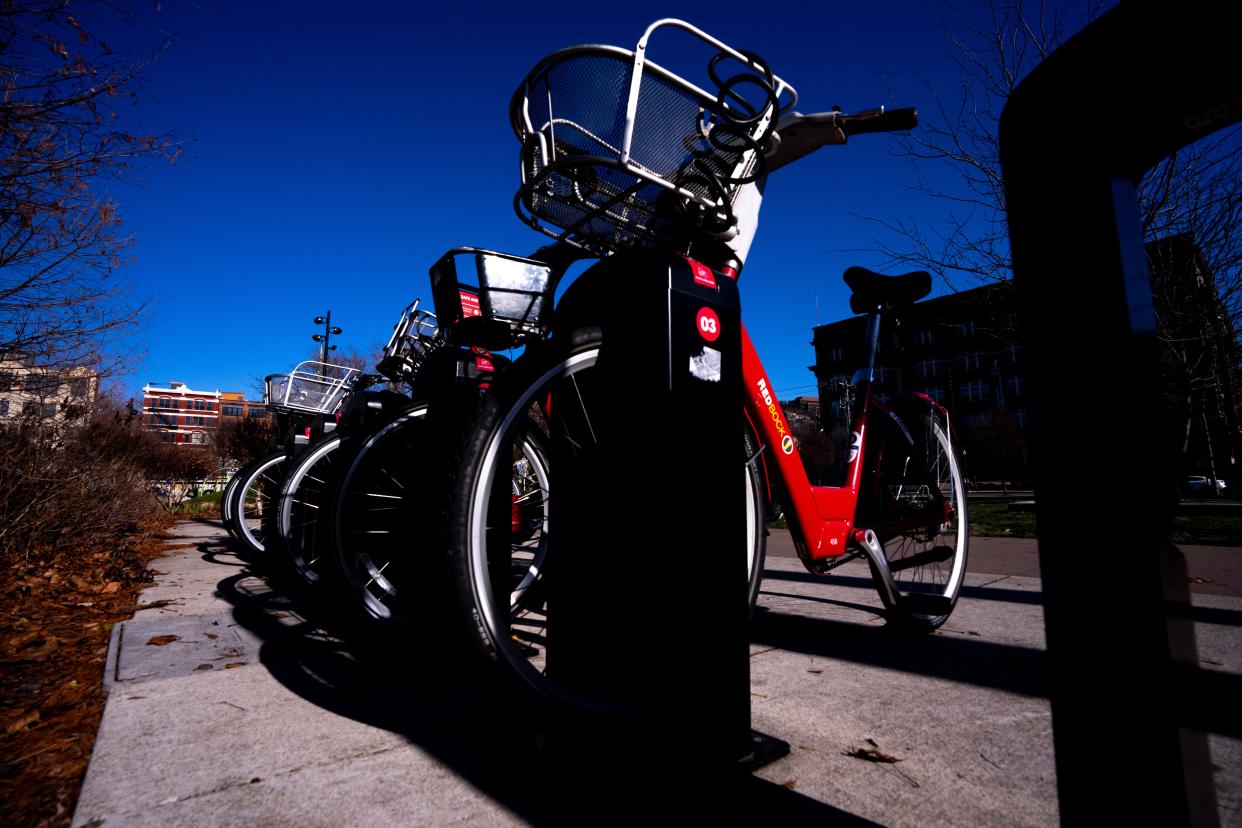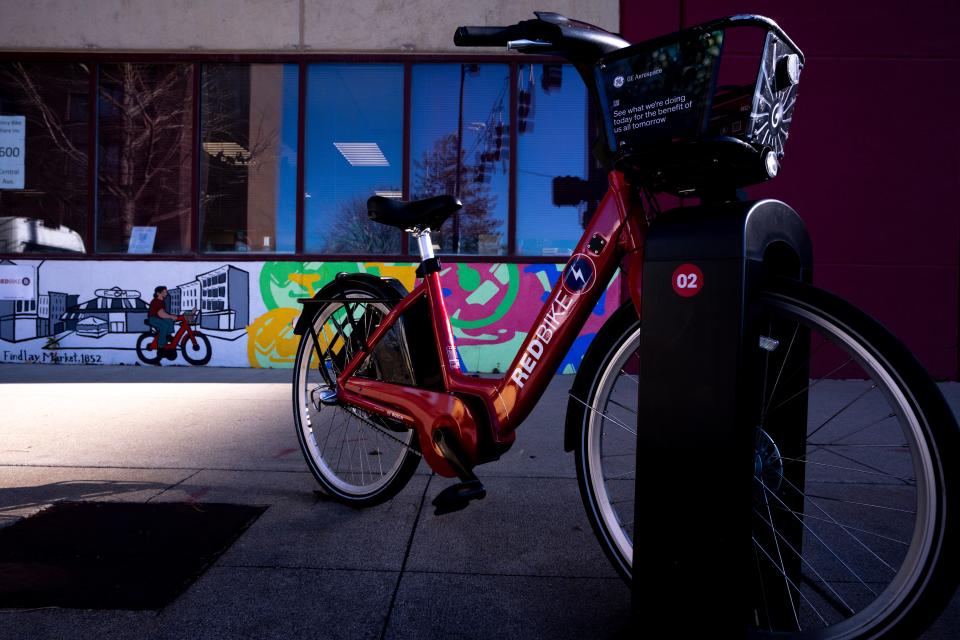Red Bike had a record year. So why is it suspending its service?

The loss of its largest corporate sponsor is forcing the temporary shutdown of Cincinnati’s popular Red Bike bike-share service.
As it moves into a 10th year, Red Bike will “reconfigure our operational structure … and be prepared to enter the spring strong,” Red Bike Executive Director Doug McClintock said.
Just hours after the nonprofit on Tuesday announced plans to stop service Jan. 12 through an undetermined spring restart date, McClintock told The Enquirer that UC Health ended its long support of Red Bike in June.
UC Health confirmed the news, saying only that it was proud to support Red Bike and that its contract ended. "We wish them all the best," spokesperson Amanda Nageleisen said in a statement.
The region’s largest medical organization had contributed about “a quarter of a million” in funding a year since the 2014 launch of Red Bike, McClintock said. It cited its own financial situation for not continuing its involvement, he said.
That support was about a quarter of Red Bike’s recent annual revenue, which sat at just more than $1 million in 2022, according to the group’s filing with the Internal Revenue Service. Red Bike collected about $515,000 in non-government contributions for the year, with about $303,000 from rider fees and $175,000 from government grants, the IRS filing showed.
With about $705,000 in expenses, Red Bike ended 2022 with a profit of about $297,000.
UC Health’s pullout, however, created “a large hole in our (2023) budget,” McClintock said.
With the pause in operations, Red Bike plans a “major contraction” of its staff of 10, he said. Those remaining will focus on the budget structuring and assembly of “a big pile of e-bikes” as Red Bike transitions to an all-electric fleet.

Ridership at an all-time high
The interruption comes as Red Bike reports its busiest-ever year, with about 144,000 rides so far in 2023. That compares to shy of 100,000 last year and 103,000 in 2019, its previous high point.
The pause in operations also comes with growth in Red Bike’s Go program, now accounting for a third of all rides. Under the program, lower-income riders pay $5 a month for a Go pass, instead of the $18 standard monthly cost.
Red Bike is likely serving a higher percentage of lower-income riders than any other U.S. bike share program, McClintock said.
“We are core and critical transportation for so many folks, but we have to figure out how to create and build sustainable, stable and continued public and private investment to make this work,” he said.
McClintock, 46, was Red Bike’s No. 2 employee from its start. Hired as operations director by Jason Barron, he took over as the executive director in August 2022 as Barron exited to become director of Cincinnati Parks.
“I was an avid cyclist when I was younger,” he said. After moves into IT work and automotive engineering, he “got the bug again” and returned to Cincinnati to work for Red Bike.
“We had amazing support from UC Health,” McClintock said.
Now, his primary goal is establishing new funding sources.

City of Cincinnati also a major contributor
In addition to UC Health, the city of Cincinnati has been a key funder of Red Bike, with commitments of close to $1.9 million. That includes:
$1.1 million in June 2014 to launch Cincy Bike Share Inc., operator of Red Bike, according to city documents.
Another $200,000 in 2019 for more stations and e-bikes, another document shows.
$500,000 more in June 2022 to expand the program in Avondale, Evanston, Roselawn and Bond Hill, other documents show. It has paid out just more than $212,000 of that allocation so far, city spokesperson Mollie Lair said Tuesday.
$75,000 through what is called the leveraged support process for fiscal year 2024. Red Bike has yet to submit required invoices to obtain those dollars, Lair said.
Cincinnati City Council member Mark Jeffreys, who is heavily involved in city infrastructure matters, called Red Bike's news "an unfortunate development."
"But I'm confident with the right players at the table that a long-term financial support model with public-private partnership will be formed," Jeffreys said in a statement. For the sake of Go pass users and "the vibrancy of our city, we need to get to a sustainable solution in the weeks ahead,” he added.
This week, Covington-based Devou Good Foundation, a nonprofit with a strong interest in transportation issues, offered $50,000 to Red Bike, according to Matt Butler, the group’s director. The Red Bike board turned it down, he said.
“This is a terrible loss for the RB Go community who count on RB for transportation,” Butler said.
Devou’s offer, which included 10 hours of consulting on fundraising, was contingent on Red Bike raising another $100,000 for its winter operations.
“Currently, we do not have the additional funds needed to operate or accept that funding due to the contingencies,” McClintock said.
Other bike shares have financial woes
Red Bike’s troubles mirror those in other cities.
In March, the 13-year-old Minneapolis Nice Ride bike share program shut down. It was unable to fill a $2 million funding gap after Blue Cross and Blue Shield of Minnesota ended its underwriting the year before, according to news reports.
In September, Houston BCycle followed suit after a decade in service, saying it could not keep up with operational costs.
Red Bike – with 72 places to rent one of its 600 or so bikes – made its financial challenges public last month, announcing plans to increase prices to ride Jan. 1.
The price increases will now go forward after the winter pause:
Two-hour passes will then cost $12, up from $10.
Monthly passes will cost $30, up from $18.
Yearly passes will cost $150, up from $100.
Go passes will remain $5 a month.
Increased revenue from rides, coupled with whatever new budgeting strategy emerges in the next few months, will be critical to support Red Bike's move to e-bikes.
By this spring, about two-thirds of its rentals will be e-bikes, McClintock said. By spring 2025, its entire fleet will be electric – the only kind its supplier still produces.
“E-bikes are a game-changer to the future of bike share, not just in Cincinnati, but across the world," McClintock said.
But they don’t come cheap. Each e-bike costs about $3,000 compared to $2,000 for non-electric bikes, and costs more to maintain.
This article originally appeared on Cincinnati Enquirer: Why is Cincinnati's Red Bike service on pause?

